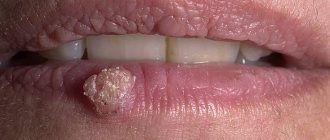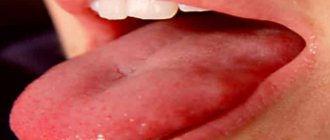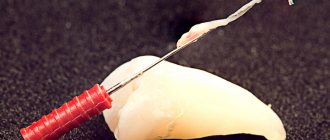What is papilloma on the tongue?
It is not difficult to detect the presence of a growth on the surface of the tongue. This growth is characterized by a rounded shape, protrudes above the mucous membrane and has a wide base.
Papillomas on the tongue are a dangerous manifestation of HPV. Symptoms: growths on the tongue are round in shape, up to 2 cm in size, similar to a nipple, with a soft consistency.
Diagnostics: differential diagnosis with oncological diseases of the tongue. Treatment: antiviral, immunocorrectors, removal.
The size of the formation is from 2 mm to 2 cm. Location: mainly on the back or edges of the tongue. In some cases - at its tip or under it. When the tumor is located near the root of the tongue, it can only be detected during a doctor’s examination or in case of extensive growth.
Removal of papillomas
Papillomas are benign formations.
From the outside, the papilloma looks like a nipple, its color is similar to the shade of nearby tissues, and its structure is soft. Both single and multiple growths form on the surface of the tongue.
Often, the presence of papillomas on the tongue is not given due attention and a specialist is visited if the growths have become impressive in size or their number has increased significantly.
The papilloma itself does not cause pain or itching. But due to frequent injury to the growth, there is severe pain and bleeding. In addition, the growth interferes with chewing, swallowing, talking, and sometimes breathing.
Papilloma on the tongue is often found in the practice of dentists and ENT doctors.
Removal is usually carried out by otorhinolaryngologists. The radio wave method is used more often than others.
Dermatovenerologist, cosmetologist
Zhikhoreva Inna Viktorovna
6 years experience
Features of the pathogen:
- Laboratory signs noticeable immediately after infection. It will take approximately 3 months before growths are detected.
- The virus can manifest itself in people with reduced immunity. In this regard, experts advise people with HPV to be tested for HIV.
- In some cases, it is possible to recover on your own. During the recovery period, warts can disappear on their own.
- Elimination of external symptoms does not lead to elimination of the viral agent. There is no specific etiological therapy; antiviral agents are used in treatment. They are effective in the presence of herpesvirus, hepatitis and other infections.
Treatment of genital papillomas on the tongue
The human papillomavirus can affect different parts of the body. The most common locations are the neck, eyelids, chest, face, armpits and genitals. However, sometimes the infection can spread to other parts of the human body. For example, a patient with HPV may sometimes find papillomas on the tongue.
At the same time, papillomatosis can affect other parts of the oral cavity, such as mucous membranes, palate, and so on. This situation is extremely unpleasant and problematic as excrement on the root of the tongue or other parts of the tongue can be easily damaged during eating, which can lead to the spread of infection to healthy parts of the mouth.
Papillomas on the tongue and common causes of their appearance
There are many factors that contribute to the appearance of papillomas under the tongue or on the tip of the tongue.
HPV most often develops as a result of weakened immunity, which can be caused by:
- pregnancy and use of contraceptives or hormonal drugs;
- hypothermia, constant stress, lack of sleep and all kinds of nervous disorders;
- bad habits such as regular smoking and frequent alcohol consumption, as well as a sedentary lifestyle and an unbalanced diet;
- hypervitaminosis or vitamin deficiency;
- taking antibiotics or other medications that can cause depression of the body's defense system.
A person can become infected either directly through contact with an HPV carrier, or through common household items that contain a pathogenic microorganism on their surface. However, a person can rarely immediately understand that he is infected, since the virus can lie dormant for a long time.
As soon as the immune system deteriorates or the body lacks useful microelements, the virus begins to progress and cause shoots in various organs, including the tongue.
The appearance of tongue tags can be caused by several strains of the virus, the most famous of which are 1-3, 16 and 18. They are also the most dangerous, since these genotypes very often cause the initial benign tumors that cause cancer.
Be sure to read soda against the papilla and HPV
Rules for recognizing squamous cell and other forms of tongue papilloma
The growths that form on the tongue can not only select different parts of this organ, but also differ in shape.
All neoplasias can be divided into two types:
- Sharp. Optically, they look like papillae or scallops. The color of such growths is usually pink. The presence of such tumors on the tongue is very unpleasant, as they constantly stick to the teeth and significantly interfere with daily life. Additionally, papillomas can easily break off due to this physical effect, causing the area of infection to expand. Care must be taken when treating such tumors as there are many veins in close proximity. It may take a long time for acute papillomas to clear;
- flat. This option is less dangerous and problematic, but also somewhat less common. The flat type of tumor does not cause discomfort. Therefore, if they do not grow widely, doctors prescribe only symptomatic therapy.
If you know what papillomas look like, you can easily recognize them yourself. You just need to look in the mirror and judge your height. Just because you have other problems doesn't mean you can ignore them. Inflammatory processes in the oral cavity are always dangerous, so they must be treated as soon as possible.
Effective treatment of genital papillomas on the tongue
It is important to understand that papillomas above and below the tongue must be treated, and not simply removed. All warts are only a manifestation of HPV, therefore, without eliminating the causes, new warts can form again very quickly.
If you want to get rid of papillomas once and for all, the treatment plan must include a comprehensive approach. Therefore, very important parts of treatment are antiviral therapy, medical and surgical removal of growth.
Medical consultation
All of these elements of treatment must be prescribed and approved by a physician. You may choose the wrong medication or choose the wrong schedule. As a result, strains that act on the tongue quickly spread to the mouth and other parts of the body.
Be sure to read Worms and Papillomas - Myth or Reality
In this case, too much medicine can harm you, and the absence of the virus allows the virus to become accustomed to its effects, ultimately rendering the medicine ineffective.
To get to the hospital, you need to know which doctor to see. If you have a papilloma on your tongue, you should first see a dentist. You should also see a doctor who specializes in ear, nose and throat, preferably an infectious disease specialist.
It is important to see your doctor in this order because if you are misdiagnosed and you are not affected by HPV and the cause is routine dentistry, your dentist will tell you immediately.
Antiviral drugs
Isolation of agents in this class is necessary to neutralize the function of HPV.
These agents help the immune system restore normal functioning and are often supplemented with vitamin complexes for best effect.
In addition, your doctor can create an individual diet for you if your specific case requires it. You should also be prepared for what your doctor will ask you to do to stop bad habits.
Choosing and taking medications
Medical treatment of neoplasms is quite complex in language and requires a complete examination of the patient before deciding on a drug. Even a small mistake in the choice of medication can worsen the patient's condition, allowing the infection to spread to other parts of the body.
After determining the strain of the virus that causes benign tumors and assessing and examining the patient's condition, the doctor may prescribe one or more medications in addition to antiviral therapy.
Before prescribing medications, the patient's oral cavity is disinfected, followed by recommendations and a list of procedures that must be followed to maintain oral health.
Methods of surgical removal of tumors
There are several ways to remove papillomas on the tongue with the help of qualified specialists. The most common option is still a scalpel.
To remove papilloma with its help, the doctor uses local anesthesia and then carries out all the procedures. If you don't like this method, you can choose other options:
- laser. With the help of a laser, you can now solve many problems, ranging from removing unwanted hair to improving vision. The history of this technique is very rich and varied, and its effectiveness deserves the highest praise. It is not surprising that laser papilloma removal has also become very popular in medicine;
- cryogenic. This is a good method to quickly remove excrement using liquid nitrogen. However, it may not be suitable for use on the tongue due to the pain it causes. Given the tenderness of the oral mucous membranes, gentler approaches should be avoided;
- Electrician. With the help of a pair of electrodes and direct action on the source of infection, papillomas can be made to disappear on their own. This method is also not painless, although it is a more interesting option compared to the cryogenic method;
- radio waves. Like the laser method, radio wave is considered one of the most attractive. First of all, it should be noted that removing papillomas in speech with its help does not cause any discomfort. This method leaves no residue, which is important if excrement is not only on the tongue, but also for the healing of the lips and skin around the mouth.
You might be interested in: Shoulder bruise. causes, types of pain, pathologies causing pain
Be sure to read Darsonval's device for removing papillomas
Another popular approach is the use of chemical solutions. It is indeed very widely used to treat diseases caused by the HPV virus, but it cannot be used for the tongue due to the unpredictability of the reaction of the mucous membranes.
Inclusion of folk remedies in the treatment of illness
Folk remedies can also be used for treatment at home. However, most of them should be examined and consulted by a doctor.
Others may also be used without a doctor's approval. However, this does not change the fact that HPV treatment must be comprehensive.
You can already take care of the quality of your immune system. It is the deterioration of the body’s protective function that most often leads to the reproduction and parasitism of HPV in various parts of the body, including the appearance of papillomas on the tongue.
Potato juice, rosehip tincture, St. John's wort, wormwood, violet and clover (can be used mixed or alone) and consumption of fruits and vegetables are all great for boosting immunity.
Video on topic
Kinds
Having identified growths on the surface of the tongue or in the throat, you need to establish what type of condyloma this is. They are divided into 2 types:
- Reactive. Papillomas are a consequence of the adverse effects of various irritants. These are mainly mechanical, chemical, thermal or infectious lesions.
- Neoplastic. Seen extremely rarely. Outwardly they resemble ordinary multiple nodular growths. They are presented in groups or single papules.
Papillomas that appear in children and adults on the surface of the tongue or in the throat are also divided into 2 types.
Pointed
This is a growth under the tongue that has a light pink tint and a sharp shape. In some cases they can grow.
Externally similar to cauliflower inflorescence. A similar neoplasm forms on a stalk. Small in size, but causes significant pain.
Sometimes there is discomfort during swallowing. Acute papilloma gets in the way, rubbing against the teeth and cheeks. The favorite place for this wart will be the area under the tongue.
You need to be extremely careful. Self-therapy is prohibited. Treatment is permissible only under the supervision of a specialist.
Flat
They are characterized by clearly defined contours and protrude somewhat above the surface of the skin. They are located in the throat, on the tonsils, on the small tongue. They do not cause any particular pain. They are extremely difficult to detect.
Why can our articles be trusted?
We make health information clear, accessible and relevant.
- All articles are checked by practicing doctors.
- We take scientific literature and the latest research as a basis.
- We publish detailed articles that answer all questions.
Any examination must be carried out by a doctor in a hospital setting. Self-treatment can have consequences for a person’s life and health. Therapy involves the use of various medications. There is no need for surgical intervention.
When such growths appear in children, their difference will be excessive growth of the tissues of the mucous membrane of the small tongue.
Types of papillomas
In most cases, papillomas appear on the tongue as a reaction to an irritant:
- Mechanical damage to the mucous membrane: thermal, chemical burns; irritation that occurs when eating spicy, sour foods; tongue injury (biting; damage from low-quality crowns, braces);
- Infectious lesions of the oral cavity.
The main types of formations are:
- Genital condylomas, having an elongated cone-shaped shape. Formations are susceptible to injury and are often injured. Damage leads to the adhesion of microgrowths, their association into islands, which cause inconvenience and discomfort;
- Flat round formations. In most cases, these growths appear on the root of the tongue and its lateral surfaces. Externally, the formations look like a large flat ridge on a thin stalk. The growths are painless, cause slight discomfort, and can interfere with eating and talking.
The appearance of condylomas is asymptomatic and results in slight discomfort. Pain occurs when papillomas are injured.
Regardless of the type of microgrowths, they must be removed and treated.
Location zones
The growths select areas on the oral mucosa that are subject to regular trauma. When the stroma is involved in the ongoing inflammation, the growth grows rapidly. This is because the stroma is the basis for the organs.
It is formed from connective tissue, which is saturated with blood and lymphatic vessels with multiple nerve endings. Such an environment is favorable for condyloma. It immediately begins to grow, turns into an ulcer, bleeds and causes severe discomfort.
New growths that are located singly on the surface of the tongue need special attention. Similar symptoms are typical for females. The result will be neuralgia.
Even if the condylomas are in a place where they are invisible, the sensations in the oral cavity cause significant discomfort.
Laser removal of papilloma in the throat. Progress in medicine helps.
The main thing is to keep up with it and take advantage of all the new opportunities. In the treatment of papillomatosis, these include the use of CO2 laser, narrow-spectrum endoscopy and certain antiviral drugs. But there is one prerequisite to achieve the best result - everything must be performed by a highly qualified surgeon with extensive experience in treating laryngeal papillomatosis. This is extremely important to understand.
Papillomatosis is characterized by the formation of exophytic growths that affect the mucous membrane of various parts of the larynx and underlying parts of the respiratory tract.
Causes
Papilloma on the tongue is difficult to remain unnoticed. Unpleasant sensations, burning, and pain are concentrated at a certain point on the surface of the tongue.
Test for human papillomavirus
The human papillomavirus (HPV) manifests itself differently in each case.
The patient looks at the affected area and discovers a small white growth that looks like a purulent pimple. The main reason for the appearance of condylomas on the surface of the tongue is human infection with HPV.
This is influenced by a number of provoking factors:
- Reduced functioning of the immune system.
- Tobacco smoking.
- Excessive alcohol consumption.
- Taking drugs.
- Chaotic sex life.
- Constant colds .
- Self-administration of oral contraceptives.
What is HPV
The human papillomavirus affects only humans, and its main mode of transmission is sexual. Therefore, HPV is most common among sexually active people. This explains the fact that most often infection occurs at a young age at the beginning of sexual activity and at its peak, i.e. 15-25 years. Moreover, several strains (types) of HPV can be present in the human body at the same time, provoking the appearance of different types of tumor-like formations on the skin and mucous membranes.
The disease caused by HPV is called papillomatosis.
Infection with the virus occurs when it comes into contact with the skin or mucous membranes with particles of exfoliated skin or mucous membrane of an infected person. They attach to the membranes of immature epithelial cells, from where they penetrate into the cytoplasm of the cell, and subsequently into the nucleus. It is the cell nucleus that contains DNA, which is damaged by HPV. As a result, when the affected cell divides, the consequence will be the formation of not healthy new cells, but those that already have altered genetic information, which leads to failures in the mechanism of their reproduction and differentiation. This causes the appearance of tumors on the skin and mucous membranes.
HPV infection can lead not only to the formation of papillomas, but also warts, as well as flat and genital warts. However, it can also be asymptomatic. In this case, the patient will not show external signs of human papillomavirus infection, but he will act as a carrier and can infect others through unprotected sexual intercourse or at home.
Thus, HPV infection does not always lead to the formation of papillomas. This depends on the strength of the person’s immunity, but more often the first small papillomas appear 1-6 months after infection.
The human papillomavirus is intracellular. Therefore, with sufficient strength of the immune system, the body successfully suppresses its activity and does not allow it to provoke cell proliferation. But when the immune system is weakened as a result of certain factors, the body’s defenses fall, the virus becomes more active, which leads to the formation of papillomas.
All strains or types of HPV can be divided into 4 groups:
- non-oncogenic – strains 1-5, 63;
- low oncogenic risk – strains 6, 11, 40, 42-44, 54, 61, 70, 72, 81;
- medium oncogenic risk – strains 26, 31, 33, 35, 51-53, 58, 66;
- high oncogenic risk - strains 16, 18, 39, 45, 56, 59, 68, 73, 82 (types 16 and 18 are considered the most dangerous).
HPV strains of high oncogenic risk have special genes in their DNA that are responsible for the synthesis of specific oncoproteins (E6 and E7). Therefore, when it is integrated into the DNA of a human cell, its anticancer protection decreases. Oncoproteins destabilize the genome of skin cells, provoke their active reproduction and suppress the ability to differentiate. Therefore, this is fraught with a high risk of developing cancer when infected with strains of the human papillomavirus of high oncogenic risk.
The magnitude of the danger that papillomas pose directly depends on the type of HPV. Infection with strains with a high oncogenic risk is dangerous due to the development of:
- cervical cancer;
- malignant tumors of the anus, vulva, penis;
- oropharyngeal cancer, etc.
70% of cases of cervical cancer are caused by infection with types 16 and 18 of HPV.
But even when infected with strains of low oncogenic risk and the formation of papillomas, they should be treated carefully. Convex neoplasms are often injured by items of clothing, bleed and tend to become inflamed. At the same time, perhaps the greatest discomfort is caused by formations on the genital organs, which cause severe discomfort and complicate the conduct of an intimate life. In such cases, a secondary infection may occur, which can cause the development of purulent-septic complications. In addition, papillomas can form on the mucous membranes of almost any internal organ, which leads to disruption of their functioning. Thus, papillomatosis of the upper respiratory tract often occurs, which causes difficulty breathing.
Symptoms
Before visiting a doctor, a person must discover what worries him. It is necessary to identify the location of unpleasant sensations on the surface of the tongue. In children, this is a shooting or aching pain; in adulthood, it is a feeling of a foreign body or persistent discomfort in a certain place on the tongue.
More specifically, it is possible to establish papilloma based on the following signs:
- The growth is located on the leg.
- The surface of the condyloma is soft.
- The shade of the wart is similar to the shade of the tongue.
- Sizes range from 2 mm to 2 cm.
The favorite place for growth is the side walls of the tongue. Less often - under it or at the tip.
The neoplasm does not provoke severe pain, but discomfort or a feeling of a foreign body exists. Often there is more than one growth; upon careful examination, it is possible to identify a whole group of minor neoplasms.
A proper attitude towards your own health will help you identify papilloma on the tongue in a timely manner.
External manifestations
External (pictured) neoplasms look different depending on the specific form. The table presents general manifestations, regardless of the specific origin of the pathology (viral, traumatic, neoplastic) due to the extreme similarity between them.
| View | Manifestations |
| Pointed | · Protrude significantly above the surface of the skin; · often multiple; · have a bumpy surface; · are on a thin stalk, hanging over the surface of the tongue; · the color does not differ from the surrounding tissues (rarely it can be lighter or darker depending on the concentration of blood vessels); · localized, as a rule, along the edge or at the tip of the tongue (they have the greatest risk of injury); · soft-elastic and painless on palpation. |
| Flat | · Have a wide base and protrude slightly above the skin (a type of wart); · diameter up to 2 cm; · more often multiple, although single ones are also found; · whitish with a smooth surface (less often they will have an intense color); · sharply demarcated from surrounding tissues; · spherical or oval shape. On palpation, soft-elastic, painless. |
There are also divisions into non-keratinizing (pale pink color and soft consistency) and keratinizing papillomas (white color and denser consistency). Often there is a weak rim of inflammation around the formation.
Both types of formations grow slowly, however, there are a number of alarming symptoms indicating possible degeneration:
- discomfort when eating food;
- bleeding (directly into the formation itself with a change in its color or into the oral cavity);
- enlargement of regional lymph nodes;
- ulceration;
- rapid growth and color change;
- the disappearance of clear boundaries and the tendency to merge;
- strengthening of the keratinization process and, as a result, compaction of the formation.
If the presented symptoms occur, a thorough diagnosis should be carried out with a number of oncological diseases, which externally in the initial stages appear almost the same as typical papillomas.
Diagnostics
The growth on the front surface of the tongue is immediately visible. It interferes with normal eating, conversation, and bleeds due to the fact that it is easy to get caught and damaged.
This provokes unpleasant pain. When the condyloma is located in the oral cavity, for example, on the soft palate or on the back of the tongue, it is possible to notice it by accident when examining the patient by a specialist. Having discovered a growth, the doctor will examine its structure.
Papilloma is soft in structure. And the shade is somewhat lighter than the mucous membrane. When it is in the oral cavity, it will be rough.
What is different is the new growth in the child: condylomas seem to cover the tongue, cover the entire soft palate, and reach the tonsils. It is much easier to detect in children than in adults.
Particular attention should be paid when examining elderly people: they often develop a cancerous tumor resembling condyloma. Only with cancer at the base of the tissue from which the growth is formed is there a clear compaction.
Treatment results
The photo below shows the results of removal of neck papillomas using radio wave surgery
Rarely occur again. Reappearance of papillomas is possible with high virus activity in the body. In this situation, additional treatment with immunomodulators or consultation with an immunologist may be required.
Treatment
A neoplasm under the tongue or in the oral cavity is treated under the supervision of a dermatologist. After conducting a thorough and comprehensive examination, he must prescribe medications. In some cases, condyloma can be removed surgically.
Self-medication is dangerous with complications!
Attention
Despite the fact that our articles are based on trusted sources and have been tested by practicing doctors, the same symptoms can be signs of different diseases, and the disease may not proceed according to the textbook.
Pros of seeing a doctor:
- Only a specialist will prescribe suitable medications.
- Recovery will be easier and faster.
- The doctor will monitor the course of the disease and help avoid complications.
find a doctor
Do not try to treat yourself - consult a specialist.
Drug therapy
Drug treatment consists of following the following instructions:
- The use of local therapy with an oil solution of vitamin A in the absence of indications for surgical removal of the growth.
- The use of interferons, which reduce the amount of viral DNA at the site of pathology.
- Simultaneous use of immunostimulating antiviral drugs.
At the moment, there is no effective remedy that could help completely get rid of HPV. The use of any medications must be agreed with a specialist.
Antiviral treatment
Antiviral therapy involves the use of medications to eliminate the development of HPV. Vitamin complexes are prescribed; they help activate the body's defenses. The specialist recommends balancing your diet and leading an active lifestyle.
According to statistics, patients with papillomas have a weakened immune system. People with high immunity are carriers of HPV, but at the same time they do not have any manifestations on the skin.
The specialist prescribes immunomodulating agents, a complex of vitamins and restorative medications. It should be remembered: immunity cannot be increased in one day with pills. Medicines are aimed at maintaining a weakened body during a critical period.
Vaccination
HPV is one of the few strains of viruses against which a vaccine has been developed. It includes organic substances that are similar in structure to the structure of living HPV viruses. Immunity against real pathogens is developed perfectly.
Before vaccination it is necessary to exclude:
- Pregnancy. Get tested or have a blood test.
- Use of serious medications .
- Other vaccinations.
- Serious diseases .
Vaccinations are given intramuscularly. Dangerous side effects are observed extremely rarely.
Preparing for papilloma removal
Before surgical excision of a wart, the patient undergoes a preliminary comprehensive examination, which includes a consultation with a dermatologist, a number of instrumental and laboratory tests. Carrying out a comprehensive diagnosis makes it possible to identify possible contraindications to surgical treatment of papillomas, assess the patient’s health status, and determine the location, number, size and distribution of skin tumors. Having studied the results of clinical studies, the doctor develops tactics to combat papilloma and refers the patient to an anesthesiologist who will select the most optimal dose and method of administering the anesthetic drug.
Excision of a wart does not require special preparation, other than a preliminary examination. The patient comes to the clinic on the appointed day, receives sterile clothing, consults with a doctor and is sent to the operating room for the procedure.
Removal
The method by which the papilloma will be removed must be chosen by the treating specialist. It depends on the location and characteristics of the body. There are the following ways to eliminate tumors:
- Surgical excision using a surgical scalpel. After the procedure, “cauterization” is performed. A similar technique is used in the presence of single growths or when they are inaccessible and it is impossible to use other methods.
- Laser elimination. The most effective, painless method with no adverse effects. The disadvantage is the high cost of the procedure.
- Electrocoagulation. The method involves cauterizing the growth with an electric current. The disadvantages include painful manipulation and a long rehabilitation period.
- Radio wave surgery. The technique is similar to the previous one, only instead of current, high-frequency radio waves act on the papilloma. The pain is insignificant, the number of adverse effects is minimal and the rehabilitation period is short.
- Cryodestruction. The most unpopular surgical method for eliminating papilloma on the tongue. The tumor is removed by influencing it with cold. The wart is frozen to liquid nitrogen temperature. The growth will be frozen and die within a week.
If the technique involves excision of the wart, then the biomaterial is sent for histological diagnosis in order to analyze the structure of the growth.
Indications and limitations for surgical excision of warts
Surgical removal can be carried out at the request of the patient or for medical reasons. These include:
- Suspicion or diagnosis of malignancy of the neoplasm;
- The presence of papillomas that have broken up into several parts;
- Pain when pressing on the papilloma;
- The presence of large and multiple warts.
Removing growths using a scalpel, like any surgical intervention, has a number of contraindications:
- Exacerbation of chronic diseases;
- The presence of an active herpes infection;
- Infectious diseases;
- Inflammatory processes in the body.
Surgical removal of papilloma can be carried out after neutralizing the causes and clinical manifestations of the pathological condition. Attempts to remove warts on your own can provoke the spread of infection and the development of an oncological process. Surgical removal of skin tumors should be performed exclusively in a specialized clinic by a professional doctor.
Danger
When papillomas occur on the tongue, the patient experiences some discomfort. So, during eating, the growth can easily come off. In addition, the formations are visible when speaking and contribute to changes in speech.
Pointed-type formations cause not only physical, but also psychological inconvenience. Against the background of this condition, a person may experience embarrassment at an appointment with a dentist or ENT specialist. Complexes also appear when communicating with other people.
The localization of growths on the inside of the oral cavity poses a serious danger, since they can provoke the penetration of another infection, resulting in an increased risk of blood poisoning. All this often leads to cancer, which often ends in death.
Causes of papillomas formation and risk factors
HPV can be transmitted sexually, as well as from an infected mother to a child during childbirth. The contact and household route of transmission of the virus cannot be ruled out, i.e. by sharing towels, clothes, etc. This explains the high prevalence of HPV in the world. Self-infection is also possible. In this case, if one papilloma is injured, the virus can be transferred to healthy areas of the skin and infect them.
The main causes of HPV infection are frequent changes of sexual partners and unprotected sexual contacts.
But infection with a virus does not always lead to the formation of papillomas, condylomas, etc. The likelihood of developing papillomatosis depends on various factors:
- immunodeficiency of any origin, including taking drugs that suppress the immune system (immunosuppressants, cytostatics, etc.), the presence of HIV infection, radiation injury;
- a decrease in the body’s defenses against the background of physiological changes during pregnancy;
- early onset of sexual activity, when the immune system is not yet fully formed and strengthened;
- microtraumas of the skin and mucous membranes;
- infection with highly oncogenic strains of HPV;
- the presence of several types of HPV in the body at the same time;
- the presence of other sexually transmitted diseases (STDs), in particular gonorrhea, trichomoniasis, herpes, cytomegalovirus infection, Epstein-Barr virus, hepatitis B and C, etc.;
- hormonal imbalances;
- exhaustion of the body, hypovitaminosis, chronic fatigue and severe stress;
- multiple births and abortions;
- the presence of severe chronic diseases, in particular diabetes;
- maintaining an unhealthy lifestyle, having bad habits;
- poor living conditions.
Older and overweight people are more prone to the formation of papillomas. At the same time, their tumors often form in the folds of the skin, which contributes to their injury and inflammation.
Prevention
It is not difficult to take measures to protect against this pathology. The likelihood of HPV infection should be minimized:
- avoid casual and unprotected sexual contacts, use contraception;
- use personal hygiene items;
- Get HPV vaccine
When infection has already occurred, it is necessary to prevent the activation of the viral agent due to weakened immunity:
- consume vitamin complexes;
- get rid of bad habits;
- avoid stressful situations and overwork.
You should not neglect HPV infection and leave its manifestations without proper treatment from a qualified doctor.
Papilloma on the tongue is a dangerous formation that requires a mandatory visit to a highly qualified doctor. The patient’s main task will be to timely detect the growth and seek help from a specialist.










